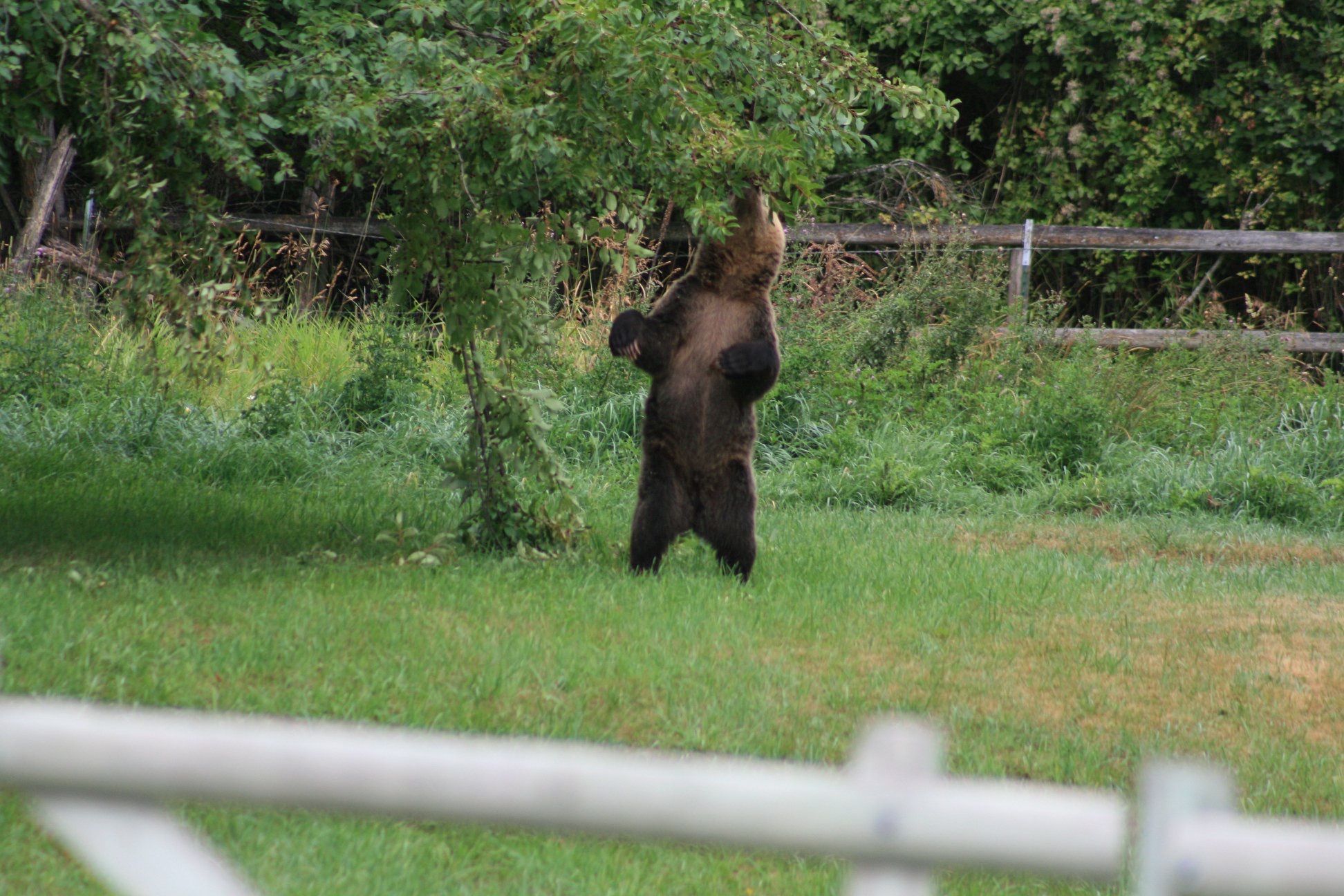Flathead Fruit Gleaning Service Deters Bears from Low-hanging Meals
State wildlife officials organize domestic fruit-picking service to stave off bears in search of easy calories, encourage residents to secure attractants
By Tristan Scott
With fall fast approaching, Flathead Valley bears are in search of low-hanging fruit — literally — as they aim to choke down as many calories as possible in preparation for winter, creating problems for bears and humans alike.
As berries run out and domestic fruit trees ripen, bruins are laying siege to easy meals blooming in residents’ backyards or littering their lawns, creating an uptick in bear-human conflicts and prompting wildlife officials to mount a fruit-gleaning campaign to reduce the abundance of domestic fruit at a critical time of year.
In late summer and early fall, bears enter a period known as “hyperphagia,” during which their hunt for fat kicks into high gear and they engage in a round-the-clock feeding frenzy.
For residents in the Flathead Valley, where a growing population intersects with the region’s wildlife-rich wilderness areas, that means nothing is off limits — birdfeeders, gardens, chickens and fruit trees, like apple, plum and pear trees.
Conflicts between humans and bears this summer have kept Montana Fish, Wildlife and Parks (FWP) game wardens busy and on alert throughout the valley as black bears have probed for easy meals on fruit trees, chicken coops, pet food bowls and bird feeders.
To that end, FWP Grizzly Bear Conflict Management staff members have created a Facebook page to connect people throughout the Flathead Valley who either want to pick fruit or have their fruit trees picked.
“Having your fruit trees picked can minimize bears getting into people’s trees and hanging around people’s property,” according to wildlife officials.
The program coordinates volunteers to help clean up the fruit, or alternately encourages residents to bring it in themselves. FWP then takes the unwanted fruit and donates it to local food banks or presses the freshly picked fruit into apple cider.
“The best way to avoid conflicts with bears is to remove or secure food attractants. If a bear does not receive a food reward it is far less likely to show up in the first place or return,” officials stated.
Beyond fruit trees, attractants often include items such as garbage, pet and livestock food, birdfeeders, livestock, compost, gardens, outdoor food cookers, and beehives.
In one recent case in July that illustrates bear-human conflict, FWP officials responded to a report of an injured black bear dragging its lower body in the foothills of Kila. The following morning, the bear was euthanized due to its injuries.
Veterinarians at Central Valley Animal Hospital X-rayed the animal and discovered it was shot with birdshot. The trash contents in the bear’s stomach indicated that it had visited a residential garbage can. The birdshot pellets broke several vertebrae in front of the bear’s pelvis and inflicted extensive damage to the soft tissue surrounding the area. According to the veterinarian, the sciatic nerve was likely disturbed, leaving the bear partially paralyzed.
According to wildlife officials, it is a common misconception that shotgun ammunition is a good way to chase away a bear. In reality, target or bird-hunting shot is an ineffective solution that often leads to unnecessary outcomes.
“Some people are under the false impression that ‘peppering’ a bear with a shotgun is a safe way to discourage a troublesome bear,” Dennis Dugger, of Central Valley Animal Hospital, said. “The shot is actually very harmful and often leads to blindness, infection and even death.”
Instead, residents should take care to secure attractants to deter bears from entering their properties.
“The best way to secure an attractant is to make it inaccessible to the animal by containing it within a secure hard-sided building,” wildlife officials stated.
Interagency Grizzly Bear Committee (IGBC) certified bear-resistant containers are useful in preventing the bear from learning that garbage could become a food source.
If containment inside a secure structure is not practical, properly installed and maintained electric fencing is another effective tool.
The Flathead Fruit Gleaning page is administered by FWP’s Grizzly Bear Conflict Management personnel, who have been receiving numerous messages from local residents looking to rid their yards of unwanted fruit.
“We felt this would be a great way to connect people throughout the Flathead who either want to pick fruit and or have their fruit trees picked,” Justine Vallieres, and FWP wildlife technician, said. “There is an increase in both people and bears in the valley and with this means more potential for human-bear conflicts. Bears are in hyperphagia and fruit trees provide them with the calories they need to den up for the winter months. Having your fruit trees picked can minimize bears getting into people’s trees and hanging around people’s property.”
People can use the page to post about trees they want picked or offer to pick trees and then provide details either on the page or through private messaging.
Areas that are in need of being picked include but are not limited to: Creston, Bigfork, Ferndale, Eureka, Whitefish and anywhere along river corridors throughout the valley.
Find more info at https://www.facebook.com/FlatheadFruitGleaning.